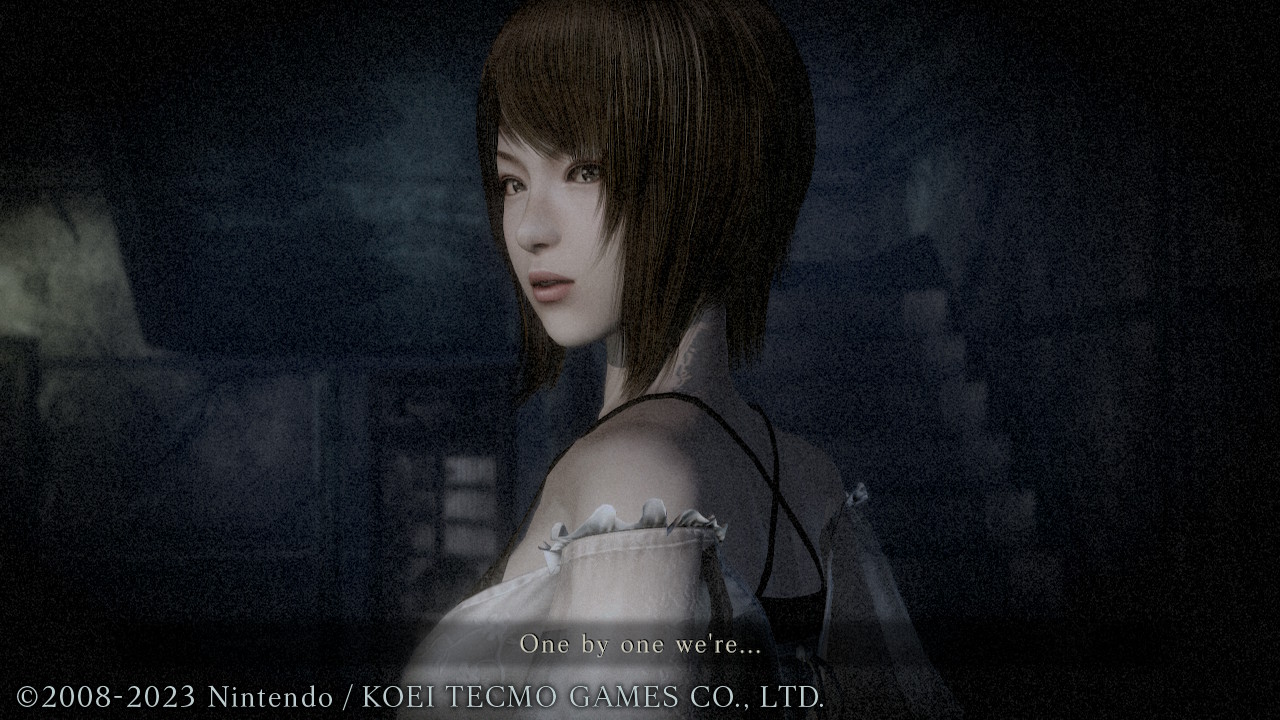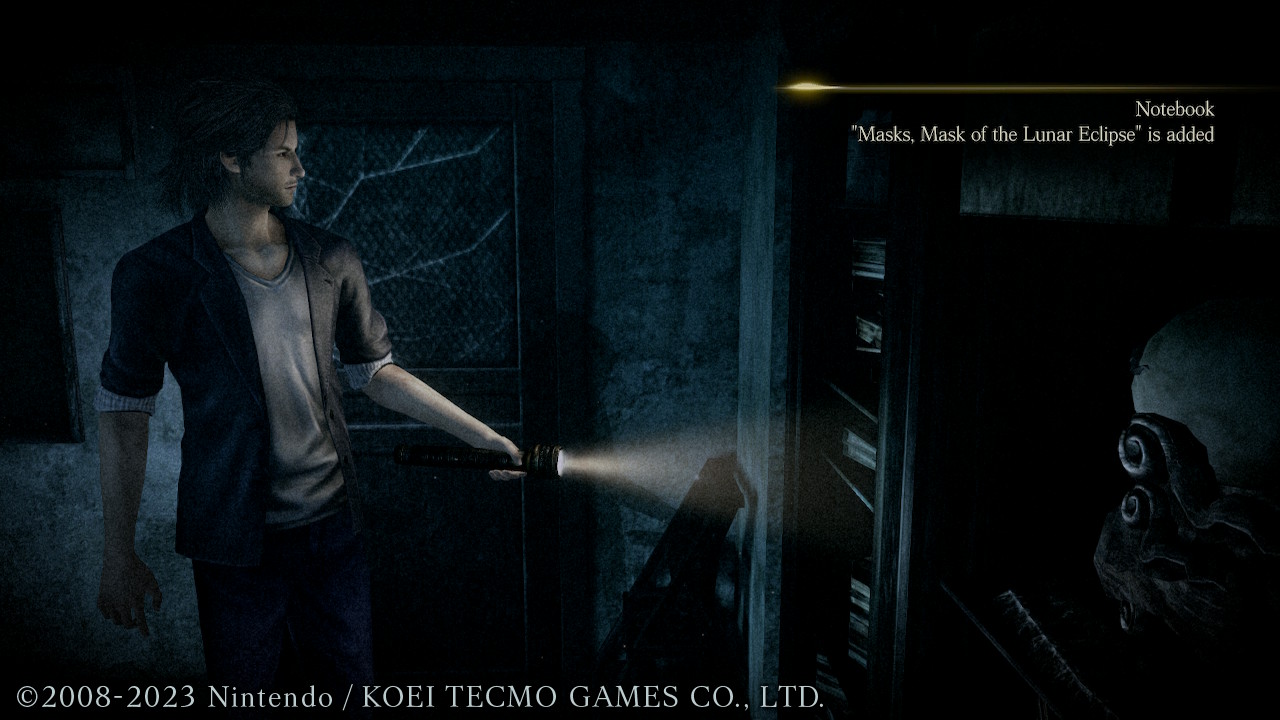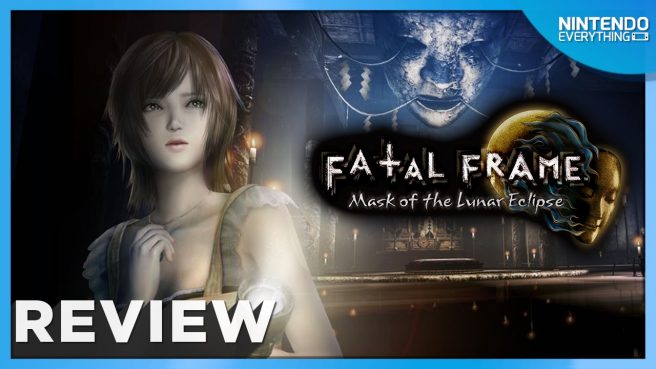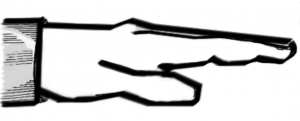[Review] Fatal Frame: Mask of the Lunar Eclipse
System: Switch
Release Date: March 9, 2023
Developer: Koei Tecmo
Publisher: Nintendo
After a whopping 15 years, the fourth mainline entry in the Fatal Frame franchise is finally accessible for English-speaking players for the first time, and as such, the release of Fatal Frame: Mask of the Lunar Eclipse feels like something of an event for horror fans. These games have long been singular experiences, possessing a unique weight that is felt in each footstep, each click of a camera shutter, each piece of unsettling lore. I was excited to finally have a chance to experience this acclaimed piece of horror history on a modern platform, and to see why fans have been begging for a localization for so long. While I enjoyed unraveling the weaving, sinister story threads of Mask of the Lunar Eclipse and soaking in its atmosphere, the game’s unrefined pacing and desperate need for extra polish should make casual horror fans pause.
Mask of the Lunar Eclipse is a much more claustrophobic experience than its sequel, Maiden of Black Water. The setting this time around is Rougetsu Island, which houses the remnants of a culture that disappeared years ago under mysterious circumstances. Each chapter of the story rotates the player through a cast of four characters who have all returned to the island for their own reasons; some seek to deal with the trauma of their dark and murky childhoods there, while others pursue a deeper understanding of the events that led to the island’s downfall. Players will guide the protagonists through the shambling ruins of the island’s medical facilities, mostly through cramped, foreboding interior spaces whose clutter alludes to the tragedies that happened there.

Exploring the labyrinthine hallways of the Haibara Infirmary and its attached residential building is a huge focus of Mask of the Lunar Eclipse; like many of its peers of the era, much time is spent looking for keys and codes to unlock pathways to new parts of the facility. And while that’s nothing new for the genre, what makes this setting unique is its detailed focus on environmental storytelling. A lot of care has gone into furnishing each room with tiny details that help provide context to what happened, and I felt myself imagining what the place looked like before it was struck with tragedy. Such authenticity can be deeply unsettling, which is exactly what I look for in a horror game.
The game also managed to get under my skin thanks to its layered and ambient sound design. Even when I knew I was safe, the low rumbling of distant machinery, or the sounds of creaking metal convinced me otherwise. Most of the music in this game sounds less like music and more like a building slowly caving in on itself, piece by piece – or, when in combat, like something is clawing its way up from hell to scream at you. Even though the sounds are pretty low-fidelity and haven’t been enhanced for this remaster – a bummer – it’s all still incredibly effective at building atmosphere.

As compelling as all this is, I wish more had been done with Mask of the Lunar Eclipse’s visuals. While it doesn’t look bad by any means, the bones of this 15 year-old game are clearly visible. Get too close to a wall and you can clearly count the pixels on the wallpaper texture, for example. There’s also a very distracting amount of film grain that always covers the entire screen, and while I’m sure there’s some level of artistry driving its inclusion, it also feels like a deliberate attempt to cover some of the visual seams, so to speak. Character models have clearly had a good amount of work done to them, and the lighting (or lack thereof) can add a lot to the experience, but don’t expect a modern-looking game when picking this up on Switch. There are also some frame rate issues here and there – not so frequent that they took me out of the experience, but common enough that I definitely noticed them.
The structure of Mask of the Lunar Eclipse also feels pretty old-school. There’s a big emphasis on backtracking and exploring the same parts of the facility as different characters. This may or may not get old for you; personally, I eventually grew so familiar with the layout of the building that exploring lost all its excitement. I don’t always mind retracing my steps in games, but Mask of the Lunar Eclipse can often be frustratingly opaque in its direction, resulting in many occasions in which I would roam around trying to figure out just what I was supposed to do next. While Fatal Frame games have always had issues with overusing their locations, Mask of the Lunar Eclipse is significantly smaller in scope than Maiden of Black Water – you rarely leave the building you start the game in – and so the appeal of exploring vanished much more quickly than I had hoped.
It also feels physically slow to navigate thanks to the tremendously clunky controls, which feel like a relic that should have been left in the past. Characters move at the speed of molasses – even while running – and the finnicky camera makes even something as simple as looking around to inspect the surroundings needlessly challenging. I don’t mind the weight of the movement, but it’s the lack of responsiveness to my inputs that adds a frustrating element to something as basic as walking. Turning up the sensitivity to max settings did help, but I still felt like my character was wearing steel-toed boots or something. If this was a deliberate choice to increase tension, it was a misguided one.

This becomes an even bigger issue in combat, which is the other major focus of Mask of the Lunar Eclipse. While exploring, the spirits of those who died on the island will occasionally appear out of nowhere. They’ll come at you from all angles, often through walls, and sometimes even from above and below you. If they grab the player, it becomes a desperate act of frantically wiggling the joysticks to free oneself, as characters will take damage the longer the ghosts are restraining them – and some of them can even kill with a single touch. Keeping them at a distance is crucial, but when even turning around and walking away feels sluggish, it feels like an artificial handicap.
Fortunately, the main weapon in the game – the Camera Obscura – remains as exciting a way to seal away entities as it always has been. Using either stick-based or gyro controls, players can fight back by aligning ghosts in the camera’s viewfinder and taking photos to deal damage. There’s a satisfying element of risk-and-reward at play here, as the closer a ghost gets to you and the longer you charge up a shot, the more damage can be dealt. Snapping the shutter right when a ghost attacks delivers a Fatal Frame, which deals extra damage and lets players quickly chain together extra shots without having to wait for the camera to recharge. It’s a simple combat system, but when ghosts start surrounding the player from all sides, it becomes a much more complicated affair. I was constantly glancing at the in-game sensor to try and determine where my next foe might appear from, and trying to avoid getting cornered in tight spaces was always thrilling.

One character wields a slightly different weapon called the Spirit Stone Flashlight. While it functions similarly to the Camera Obscura, this item can take particularly powerful shots, but needs to be recharged after a certain number of shots by temporarily “holstering” it. This adds an extra wrinkle to combat, as it becomes a game of trying to manage shots by getting as many ghosts into the flashlight’s range as possible. Both weapons can be equipped with different types of lenses to augment combat further. For example, the Push Lens shoves enemies back a little bit after a successful shot, and the Slow lens slows them down slightly. There aren’t a lot of them to pick up, but the ones that do exists are all valuable and worth seeking out.
All these components can be upgraded over the course of the game by investing Spirit Stones into their various attributes, doing things like increasing shot power or reducing the time between charges. This ties into why exploring thoroughly is so important, as most Spirit Stones can only be found by shining your flashlight around the environment until something glimmers. A radar feature of sorts lets you know when something is nearby, but the actual act of aiming the flashlight Is a bit of a pain. In the Wii release you could use motion controls to aim – unfortunately, the only way to aim in this version is the right joystick, which isn’t nearly as precise.
Between battles, visiting lanterns allows the player to save the game, and trade Spirit Points for consumables, like healing items and more powerful film for the Camera Obscura. Spirit Points can only be earned by photographing ghosts, but on normal difficulty I always felt like I had enough to stock up on what I needed. But save points can be frustratingly scarce, meaning that death can result in a good chunk of progress being lost – sometimes 20 minutes or so. Which, fine, but with the already high amount of backtracking in this game, I always was a bit exhausted with having to redo a chunk I just completed.

What made all these gripes worth it was Mask of the Lunar Eclipse’s story, which is mostly told through notes and journals scattered around the environment. These are impeccably written, and each one slowly reveals small tidbits of who these characters were, and what their role was in the tragedy that resulted in the downfall of the island. I really began to empathize with the victims over time, as I began to realize the implications of the situations that the protagonists were forced into. Even the way the prose is organized and paced on the pages is creative and compelling. It’s impressive and shocking how effectively this game’s writers can sell the premise of certain characters going insane, or acting out of desperation, for example, through words alone.
Still, the pace at which all this is revealed is glacially slow, and while I think the narrative payoff is ultimately worth it, there’s no real character development to speak of with the playable protagonists for most of the journey. Because the structure is based around discovering what happened in the past, very little happens in the present day, and so narrative progression is directed mostly by the rate at which players discover interesting notes. Eventually I reached a point where I felt like I had uncovered most of the history of the setting, but still had several chapters left of game to meander through. Despite not being a super long game, Mask of the Lunar Eclipse feels like it could have used a more compelling modern-day scenario to drive things forward more efficiently.
The Verdict
Fatal Frame: Mask of the Lunar Eclipse isn’t as compelling as the newest entry in the franchise – its controls and visuals haven’t quite been brought up to the level they should have for this remaster, and the repetitive structure and slow pacing could alienate newer players. That said, beneath all these eccentricities is a haunting and thoroughly creepy mystery to uncover, and it’s backed up by the tense push-and-pull ghost-capturing gameplay that remains one of this franchise’s most unique and fascinating systems. Horror fans who are dedicated to seeing the story through to its completion will almost certainly be satisfied with the incredible atmosphere and writing, but be prepared to take the good along with the quirks that accompany 15 year-old game design.
Fatal Frame: Mask of the Lunar Eclipse copy provided by the publisher for the purposes of this review.

